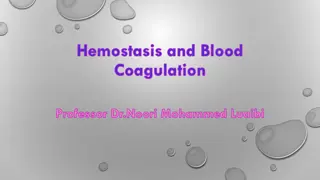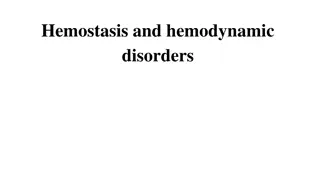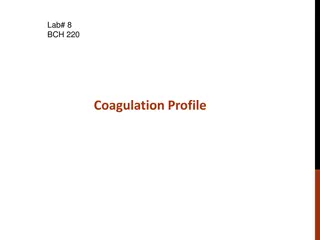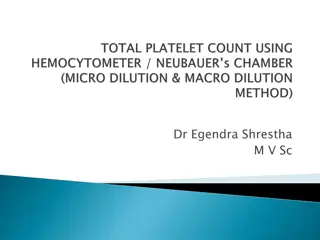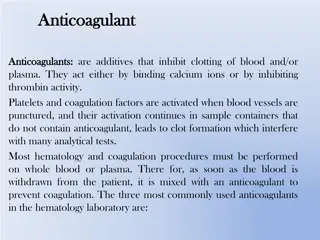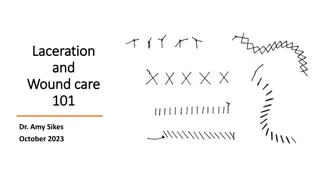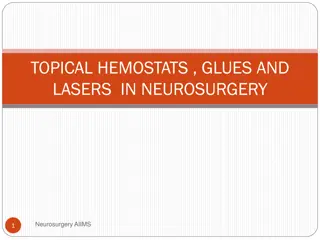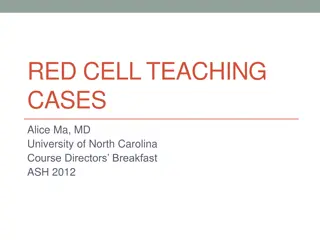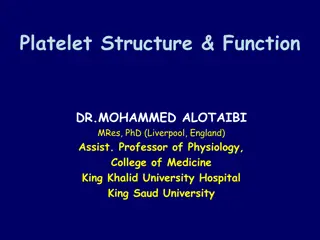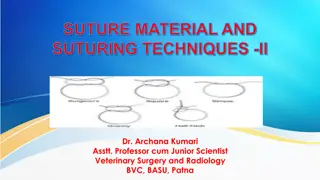Understanding the Clotting Cascade and Hemostasis
The clotting cascade is a complex process involving intrinsic and extrinsic pathways that converge to form fibrin, leading to clot formation. Hemostasis is initiated mainly through the extrinsic pathway in vivo, activating factors that generate thrombin and ultimately convert fibrinogen into insoluble fibrin. The aPTT and PT tests measure the integrity of the intrinsic and extrinsic pathways, respectively.
Download Presentation

Please find below an Image/Link to download the presentation.
The content on the website is provided AS IS for your information and personal use only. It may not be sold, licensed, or shared on other websites without obtaining consent from the author. Download presentation by click this link. If you encounter any issues during the download, it is possible that the publisher has removed the file from their server.
E N D
Presentation Transcript
The clotting cascade (minus the natural anticoagulants)
Start with the bottom line: fibrin formation. After all, this is what the clotting cascade is designed for Fibrinogen Fibrin
Intrinsic pathway Extrinsic pathway 2 ways to get to bottom line: 1. Intrinsic pathway 2. Extrinsic pathway Fibrinogen Fibrin
Extrinsic pathway is initiated when blood is exposed to subendothelial surface, where factor VII (FVII) comes into contact with tissue factor, leading to activated FVII (aFVII) Intrinsic pathway Extrinsic pathway aFVII FVII is the only factor in the extrinsic pathway Fibrinogen Fibrin
Intrinsic pathway aFXII Extrinsic pathway aFVII Intrinsic pathway is initiated when blood is exposed to negatively charged surface such as glass or clay, leading to activation of FXII Fibrinogen Fibrin
Intrinsic pathway aFXII FXI Extrinsic pathway aFVII FXII activates FXI, which in turn activates FIX (only the inactive factors are shown for simplicity). FIX activates FX of the common pathway using FVIII as a cofactor FIX FVIII FX Fibrinogen Fibrin
In vivo hemostasis is always initiated by the extrinsic pathway. Once activated FVII activates FX of the common pathway and FIX of the intrinsic pathway Intrinsic pathway aFXII FXI Extrinsic pathway aFVII FIX FVIII FX Fibrinogen Fibrin
Intrinsic pathway aFXII Extrinsic and intrinsic pathways converge on FX of the common pathway. Once activated, FX (and its cofactor FV) activate prothrombin, leading to thrombin generation. Thrombin, in turn, cleaves fibrinogen, leading to formation of insoluble fibrin FXI Extrinsic pathway aFVII FIX FVIII FX FV Common pathway Prothrombin thrombin Fibrinogen Fibrin
aPTT PT measures integrity of the extrinsic pathway by activating FVII Intrinsic pathway aFXII PT aPTT measures integrity of the intrinsic pathway by activating FXII FXI Extrinsic pathway aFVII FIX FVIII FX FV Common pathway Prothrombin thrombin Fibrinogen Fibrin
In vivo hemostasis 1. Hemostasis starts with tissue factor-mediated activation of FVII 2. aFVII activates FIX in intrinsic pathway 3. Both aFVII and aFIX activate FX in the common pathway, leading to thrombin generation and fibrin formation 4. Thrombin feeds back to activate several factors, including FXI of the intrinsic pathway. The importance of FXI in hemostasis varies between individuals We need to consider FXII when performing an aPTT because deficiency FXII can lead to a prolonged test result. However, FXII does not play a role in in vivo hemostasis. So, let s remove it from the scheme. FXI 2 1 aFVII FIX 4 FVIII 3 FX FV Prothrombin thrombin Fibrinogen Fibrin
One more step to remember: fibrin is crosslinked by factor XIII (FXIII), making it strong and insoluble. PT and aPTT assays are unable to tell the difference between uncrosslinked and crosslinked fibrin. Other assays are required to demonstrate FXIII deficiency In vivo hemostasis FXI 2 1 aFVII FIX FVIII 3 FX FV Prothrombin thrombin FXIII X-linked Fibrin Fibrinogen Fibrin





